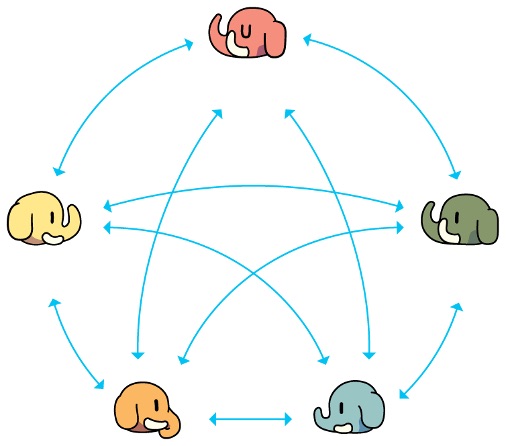I can't seem to find documentation on what content types #Mastodon supports in the actual "status" content. I've seen posts with inline links and basic formatting, but don't know how to post them.
Entries for #mastodon
page 1 of 1
Replying to a Mastodon post from the blog
Fedi/Mastodon programmers... with the #MastodonAPI, and given a url to a post on any instance (assuming I have access to the toot from my account), how might I get my instance to fetch it and give me a "local" ID that is suitable for passing as the "inReplyToID" in a toot payload?
Wondering if I need to:
- perform a search (https://docs.joinmastodon.org/methods/search/)
- find the relevant status in the results
- use the ID for the status
Would that be the "local" ID #MastodonAPI #fediverse #programming #blogging #indieweb
Time for bi-yearly web presence maintenance
What with Twitter (aka birdsite, hellsite, muskosite) flailing in the clammy hands of Dr. No, and interest in the federated web re-emerging, I figured it was time to review my own web presence and see what was the situation.
(SORRY, LOST IMAGE)
Dear reader, it was Not Good.
Warning one was hitting this site from my work network and getting a BitDefender screen of doom saying the site was serving a keylogger. NOT GOOD.
Then the site - which was hosted on Linode and runs my own homegrown blog software, Goldfrog - went completely down. After some "where did those ssh keys get to, where is this thing anyway" I got logged in and figured out that my server had been hacked in some way, TLS and letsencrypt removed. I haven't had time to troll the logs for evidence as to how the server was accessed, but I downloaded them and have them set aside to look later.
We Can Rebuild It
Thus entered a week of figuring out once again how the heck Monkinetic is built and deployed, migrating the code from Github to Gitlab (which I'm more familiar with due to $dayjob), and refactoring the Ansible code that builds the server and deploys the blog/content.
Finally today I got it 85% done, which is pretty good for a full migration between hosting providers (I also moved from Linode to Digital Ocean where I already have some other services).
Masto-tootly-don
With the insanity on Twitter, I logged back into my Mastodon account on toot.cafe and enjoyed the huge stream of new folks migrating from Twitter to federated platforms (mostly to mastodon.social since that's the first/largest instance, but folks are making their way from there to smaller instances as they get more comfortable).
Apparently Mastodon 4.0 is out (release candidate) and they've changed the annoying-until-it-was-gone "Toot" to "Publish". I'd have preferred "Post" myself, but 🤷♀️.
to-show-or-not-to-show tags: mastodon,playviscious,ui title: Post Activity in Mastodon - to show or not to show twitter_id: "1232318268884389888" twitter_url: https://twitter.com/steveivy/status/1232318268884389888
For the most part I appreciate the design decision that the #mastodon developers made to not show reply/boost/fave numbers on the feed lists, because it puts more focus on the content and less on gaming an algorithm for popularity or "engagement".
(SORRY, LOST IMAGE)
but I also realize that this makes it harder to know if there are responses! For example, this post by Jun on #playviscious actually has an interesting thread that I'm learning from, but nothing in the UI signifies that there is more content to find connected to the post.
I wonder if there could be an additional affordance in the #UI that there are replies (boosts and faves not so much)?
you know what would make my timeline amazing? A "turn of retweets for e'r'buddy" setting #noretweet #noboost(#mastodon has it why don't you)
The Revolution Will Be Federated
Much has been made lately about Twitter having become a trashfire, with rampant trolling and abuse of women, monitories, and non white-dude-being folks. Being a white dude in tech, I was generally ignorant of the direction things were going, as my timeline was mostly other white dudes in tech congratulating themselves for their cleverness.
Around the time that GamerGate was blowing up, I made the concious decision to start following a larger variety of people on Twitter, in an effort to break out of the cocoon I found myself in. One day I need to write a post about that, but this is not that post.
This post is about how I discovered that, while I wasn't looking, an alternative began growing up from its very nerdy roots and is becoming something real people could - and should - use.
Life In The Silo
The major social media sites - Twitter, Facebook - are commonly referred to as silos - great collections of content with few connections to the outside world. Content flows in from users (and the web) but not out again.
The picture I've recently started forming is the Dystopian Underground Community from the science fiction genre: The Haves live near the surface, in the Silo's highest levels, blessed by light and air (and attention). The Have-Nots live below, garnering less and less light from the source, instead inheriting the castoffs and scraps dropping from the levels above them. The Upper-Midlevels can still see the light clearly, pretending that they are not dependent on the goodwill of the Haves for access, and pretending that there are not hundreds of levels of population below, struggling for life.

The residents in the Midlevels are used to life in the twilight, move in their circles of family and friends, and have grown to believe that making a life from the hand-me-downs from above is normal. They know of the lower levels, they depend on services that the residents there provide from time to time, but are convinced that either life there is not so bad, the residents are living in the dark by choice, or the worst: believe that they have earned the right to the light, rather than being born to it, and those below somehow don't deserve access.
The further one's social circle gets from the dominant Haves, the deeper into The Below, the harder life in the silo becomes. The Below is rife with roving gangs of trolls, descending even from the Midlevels where they live in relative comfort, to harass and abuse the citizens struggling to make ends meet on the scraps of attention and spaces left to them by the Haves and those in The Above. The trolls have little to fear from The Below, save the reminder that they too are Below - somon else. And perhaps it is that thought that drives them to stand on walkways and corners, hurling insults and petty self-justifications at the passing residents.
The Silo is a terrible place for those not born into, or assigned to, the upper levels. Fortunately, there is hope: The federated Colonies...
The Colonies
Out on the surface, separated from the Silo, a new set of colonies is being built. Each colony is self-sufficient, with resources for every inhabitant, and attention to spare. Some are small - just a few tens or hundreds of inhabitants. Others are massive, home to hundreds of thousands of residents. Here the domed and towered structures bask in the light, with a vitality and energy long since lost in the Silo.

The colonies are home to nearly a million former residents of the Silo. Some still descend into the Silo to visit family, friends, and invite others to the colony. Some have moved permanently, homesteading a new network of sheltered structures here. These colonies are a federation - communication and residents move freely from one to the other, local administrators making sure that their respective codes of conduct are maintained, provide space and facilities for the residents, and coordinate relationships with the other colonies. Residents find a colony of likeminded individuals, and can move from colony to colony as desired, with some paperwork to transfer residency.
This isn't a utopia; there are always disagreements - we're human after all - and adminstrative conflicts have led to colonies disassociating with one another. But here on the surface they are free to do choose their connections, joining and leaving the federation as desired.
Leaving the Silo
If Twitter and Facebook are the Silos, blessing the privileged while taking advantage of the Outsider and the Other, the Colonies can be found in the federated web, the open social networks - sites like Mastodon, Diaspora, Friendica, and GNU Social.
Mastodon in particular has established itself as a viable alternative to the murky depths of the Silo. With a million-plus users spread over more than a 1000 instances, each server, or colony, is a full-fledged social network, with users posting, sharing, following, and liking each other's content. But more than that, each user can remotely follow users in other servers, bringing new viewpoints and content into their space.

Is a migration to federated social media sites going to break the power fo the Silos? No. There are enough users happy to be near their friends and family, or eager to harangue and harass those in The Below, while jealously eyeing The Above.
But maybe some at every level of the Silo will find themselves looking for something better, a place with something for everyone, a system that is not designed to entrap and enclose them, and make them subservient to the whims of execs and advertisers.
The Revolution will be Federated.
- Tunnel image by Ishutani
- Colony image by Ken Fairclough
- The Silo concept was partially inspired by Hugh Howey's book WOOL
page 1 of 1